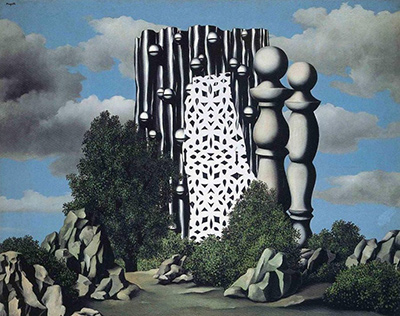Painted by Magritte in 1930, The Annunciation is a visually stunning piece that appears to depict a sheet of metal with sphere, or bells, protruding from it. A white section with the appearance of cut paper contrasts with images of stone pillars or balusters.
Like much of his work in this period, The Annunciation is a surrealist work with the strange collection of objects having a real sense of belonging with the rocky outcrop on which they stand. It is one of the largest pieces that Magritte ever completed, and the scale of ambition is realised in the way the 'old master' handling of light and the ominous grey tones in the background blends seamlessly with the surrealist elements.
Although some believe Annunciation was completed in 1929, there is documentary evidence including letters and sketches from Magritte himself which show the piece was not completed until 1930. This was a difficult time for artists; the depression had made selling artwork almost impossible, and Magritte's wife recalled existing on gifts from friends during this period.
The work was first displayed in 1931, and this is also the first mention of the title. Although there is no overt religious imagery in the piece, there is a sense of import to the scene that suggests something either has, or is about to, happen of great significance. Magritte was not a religious man, so it seems likely that he did not choose the word for its religious connotations.
The Annunciation came into Magritte's dealer's hands (Mesens) in July 1930, and it was first exhibited in Brussels in 1931. Although briefly owned by Alex Salkin, a friend of Magritte's, the piece returned to Mesens' collection where it remained until his death in 1971. Although the painting did not receive critical acclaim initially, it has recently been considered as one of Magritte's most important works. The Annunciation has been widely displayed in the decades since its painting. It is currently part of the Tate Modern collection where it is part of the International Surrealism display.




